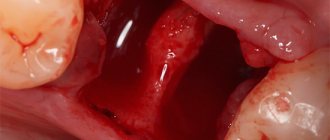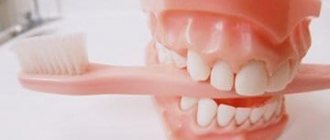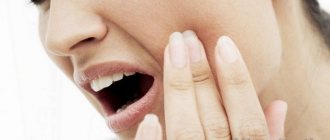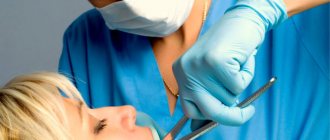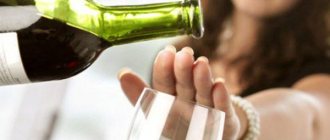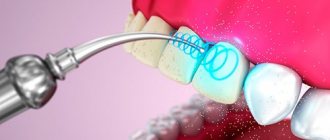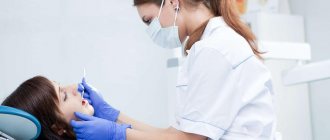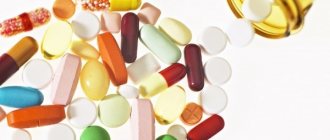What to anoint for healing gums after tooth extraction?
Medicinal gels and ointments are an excellent way to relieve pain , reduce tissue redness , and also gum healing
You can start treating the wound no earlier than 2 days after removal.
When processing, do not apply strong pressure to the affected area.
Today, pharmacies offer a wide range of products ; let’s discuss the most common and effective remedies.
Attention! For rapid healing of the gums, the first days after the removal procedure, you must adhere to general recommendations. pain relievers and infection preventatives as needed oral hygiene , maintain proper nutrition , and get adequate rest .
Levomekol
Levomekol is an inexpensive but effective drug. In addition to dentistry, Levomekol is used in pediatrics, surgery and proctology . According to statistics, this ointment is one of the 10 most recommended for healing wounds in the mouth, as well as for purulent fistulas, periodontal disease and gingivitis. The ointment has the following properties:
- healing,
- regenerating,
- anti-inflammatory,
- antimicrobial,
- tonic.
The main components of the drug are Methyluracil and Chloramphenicol . Polyethylene oxide is used as a base .
The ointment must be applied to the finger (hands must first be washed and treated with an antiseptic) and carefully applied in a thin layer to the sore spot. It is allowed to apply a sterile swab with ointment, but in no case should the swab put pressure on the affected area of the gums. The tampon is applied for 30 minutes .
Photo 1. Ointment for external use Levomekol in a volume of 40 g. from .
Before the first use, it is recommended to conduct an allergy test (on the bend of the elbow). An allergy to the drug manifests itself in the appearance of a rash on the mucous membrane, urticaria and a burning .
Vishnevsky ointment
Vishnevsky ointment is an antiseptic , the author of which was the famous surgeon A.V. Vishnevsky . An ointment unique in its properties was obtained by mixing birch tar, castor oil and xeroform . It promotes rapid healing , regeneration , has disinfectant and antibacterial properties, and also reduces pain . In addition to treating gums, the ointment is used for purulent and trophic ulcers, burns, frostbite, carbuncles, boils and wet calluses .
It is recommended to apply the ointment with a clean finger to the wound or first apply it to a swab made of a sterile bandage . Recommended exposure time is 30 minutes .
Reference. It is recommended that the time of application of any gel or ointment be previously agreed with the attending physician , since it is individual .
Gel Solcoseryl
Solcoseryl gel is used as a stimulator of the restoration process in tissues and to normalize metabolism . It normalizes anaerobic oxygen metabolism , increases collagen synthesis , increases fibroblast , creates energy reserves in cell mitochondria and maintains oxygen supply to cells.
Photo 2. A popular remedy for healing gums, Solcoseryl, is also available in the form of an ointment.
The gel contains dialysate made from the blood of young dairy calves, which allows the drug to actively activate cellular metabolism . The gel is used for erosions and ulcers in the oral cavity , for postoperative wounds and for bedsores under dentures.
Important! During the healing period of the hole, the following symptoms may appear: pain radiating to the adjacent tissues; short-term bleeding ; swelling and redness of the gums; short-term dysfunction of the jaw and impairment of its functionality; hypothermia (up to 38 degrees).
Solcoseryl is applied locally or on a medicinal bandage , which creates a protective layer on the affected mucous membrane of the oral cavity. The wound must first be treated with an antiseptic and the mouth rinsed . The gel is applied 2-3 times a day (after meals and at night).
Holisal
Cholisal is a combination drug . It is an antimicrobial and anti-inflammatory agent, and can replace an analgesic . The main components of the drug: Cetalkonium Chloride and Choline Salicylate . They soften injured areas of the mucosa. The gel promotes the healing of wounds and erosions ; it is used for periodontitis, gingivitis, cheilitis of the tongue, lichen on the gums, yeast stomatitis and injuries on the gums (and near the teeth).
The gel is applied to the prepared surface with a finger or a cotton swab.
It is also possible to apply a small amount of the drug to a sterile cotton swab and apply to the sore spot for 15 minutes .
The wound must first be treated with Miramistin or hydrogen peroxide . Cholisal can be used no more than three times a day (until the wound heals).
Asepta gel
Asepta gum gel is used to prevent inflammation and strengthen gums. The gel is made on the basis of natural propolis , which makes it effective and safe . Indications for use of the drug: injury (as well as increased sensitivity), periodontitis, gingivitis, stomatitis and trophic ulcers .
After brushing your teeth, apply the gel (a thin layer) to the surface of the damaged gum. After application, it is not recommended to eat or drink for 30 minutes . Use the gel 3 times a day for no more than 14 days . To prevent gum problems, courses are conducted:
- 2 times per year,
- by prior agreement with the dentist .
Instructions for use of Solcoseryl for gums
Depending on the severity of the disease, Solcoseryl for gums and other parts of the mucous membrane can be applied up to 3-5 times a day for a week. Before application, the mucous membrane must be treated with antiseptics (chlorhexidine bigluconate solution 0.05%, Miramistin). Cotton swabs are used for this purpose. Movements during treatment should be smooth and careful to avoid injury to the affected soft tissues. Then the mucous membrane is dried with cotton wool.
Solcoseryl toothpaste is applied to the lesions using cotton swabs pre-moistened with water. The drug should be used immediately after meals, 2 hours before meals and before bedtime. The dental dressing should remain in the mouth for at least 1.5-2 hours. In children, application is carried out by adults. It is also important for the child to maintain the exposure period of the paste.
There are a number of features when performing treatment in case of various diseases of the oral cavity. Solcoseryl for stomatitis is used only at the stage of beginning epithelization of erosive and ulcerative lesions. Since this disease is often combined with a microbial factor, during treatment it is necessary to use an antiseptic drug before applying the paste.
Against the background of alveolitis, Solcoseryl after tooth extraction is also used only after all inflammatory phenomena in the mucous membrane have subsided. If sutures are required after treatment in the area of the extracted tooth, the effect of the drug will not be pronounced. If bedsores occur under removable orthopedic structures, after applying the paste to the mucous membrane, the prosthesis is moistened with water and installed.
Some people may experience allergic reactions when used. More often they manifest themselves in the form of itching, burning, and redness in the area of application. To solve the processes of mucosal restoration, you can select analogues of Solcoseryl.
They mainly use Holicet or Metrogyl Denta gel. The selection and replacement of a medicinal product is carried out only by a doctor. It is not advisable to use other medications on your own, as this can cause the development of adverse reactions.
Solcoseryl paste is a drug that effectively has a therapeutic effect on lesions of the oral mucosa and is approved for use in infants. The use of the medicine must be strictly agreed with the doctor and used in accordance with the instructions. If any adverse reactions occur, you can always choose an analogue of Solcoseryl.
Author: Evgenia Korotaeva, dentist, especially for Karies.pro
Ointment after tooth extraction - which one is better to choose?
Interesting fact No. 7 “According to statistics, 86% of patients who used the ointment after tooth extraction had no complications”
Even if it so happens that you have a tooth removed, you don’t need to be upset. On the contrary, you need to watch your remaining teeth with double concern and trepidation. You should also follow all the instructions from your dentist, who will definitely prescribe you an ointment after tooth extraction, antibacterial mouth rinses, painkillers, a sophisticated diet, etc.
Well, today we’ll talk about ointments and gels used to restore the health of the oral cavity after tooth resection.
Only practice is better than theory
Feedback from consumers who use Solcoseryl paste will help clarify how things really stand.
A dental dentist recommended Solcoseryl to me when I came to him with my daughter for a routine check-up. My five-year-old baby developed stomatitis.
The doctor advised us other remedies, but emphasized that the paste was best suited. However, having bought it, I doubted whether the drug would be enough for complete recovery: it was a very small tube. It was enough for us until the disease disappeared, which was already on the fifth day, and there was still a little left in the tube. Very pleased with the effect!
Read also: Paste that reduces tooth sensitivity
Anastasia, 07/13/2015
I have had problems with oral “sores” since childhood. But if at that time they covered them with brilliant green, and the pain was terrible, then at the age of 26 you can no longer use this, since there are fillings. On the advice of the dentist, I bought Solcoseryl dental adhesive paste.
I really liked its effect: the wounds stopped hurting immediately, and after a few days I stopped even thinking about the disease. The main thing is that it smells pleasant and after use you are not ashamed to talk to people.
Valentin, 21.11.2015
The doctor prescribed the paste to me after the removal of a wisdom tooth. There was a large wound and the gums were badly damaged. True, there was no need to put stitches. After applying the drug, the pain quickly subsided, which brought relief.
There were no complications and the wound healed quickly. Even though the tube was small, the paste was still enough for my son to treat his sore gums. The treatment result is excellent, and the cost of the paste is quite reasonable.
Lyudmila, 03/15/2016
Top 3 best ointments and gels
Solcoseryl gel . An effective and affordable drug in gel form. Excellent for healing lacerations formed after resection (removal) of teeth, surgical operations (removal of fistula, cyst) on soft tissues of the oral cavity.
The drug contains polidocanol, which promotes the speedy healing of lacerations on the gums such as cuts, bruises from injections, scratches, calluses from dentures.
Apply a small amount of gel to the wound no more than three to four times a day. The drug has no contraindications, only undesirable use during pregnancy and lactation. Use the gel only after consulting a doctor. The average cost in city pharmacies is 300 rubles.
Metrogyl denta gel . Multi-purpose drug from a large Indian. Many dentists prescribe Metrogyl gel for:
- Lacerations and cuts to the gums, tongue and cheek;
- With the development of gingivitis;
- Aphthous stomatitis;
- Alveolitis,
- Periodontitis,
- Abscess.
The drug contains metradinazole and chlorhexidine, which together effectively destroy aerobic bacteria. Therefore, the gel is excellent for healing wounds after tooth extraction.
The course of treatment is from two weeks, the gel is sold without a prescription, the average cost is 160 rubles, it has no contraindications. Does not have a pleasant taste or smell, safe for children.
Asepta . The Russian drug is available in the form of an ointment for the treatment of gum diseases, lacerations after tooth extraction, allergic reactions, stomatitis, plaque and fungal infections. The drug contains propolis, which promotes lightning-fast healing of wounds, scratches and cuts.
The ointment should be applied in a layer of medium thickness four to five hours before meals, two to three times a day. Available without a prescription. The average cost in city pharmacies is 550 rubles.
Application and dosage regimen
Solcoseryl dental paste is applied in a thin layer without rubbing onto the wound. The procedure is carried out 3 to 5 times a day, depending on the severity of the wounds or lesions. Treatment is carried out after meals and before bedtime.
When interacting with saliva, the paste is transformed into a kind of film that reliably protects the wound for several hours.
The dosage depends on the size of the affected area. Often, to treat the affected area, it is enough to use 5 mm of the drug squeezed out of the tube. The course of treatment can last until the paste is completely used.
Features of application
The drug should be applied to a wound pre-treated with an antiseptic.
Miramistin solution can be used for disinfection if stomatitis is being treated. In all other cases, it is better to use a solution of Chlorhexidine 0.05%. The affected or damaged areas are treated with gauze or a swab soaked in an antiseptic. After this, the wounds are dried using dry swabs, and only then the paste is applied.
If bedsores formed under dentures are being treated, then the removable teeth must be dried, the preparation applied to them in the area adjacent to the gums, moistened with water and inserted into the oral cavity.
If there are affected areas in the oral cavity caused by infection, they must first be treated with appropriate medications that have an antibacterial effect.
Only after this can the paste be applied to the wound. Since it does not contain antimicrobial components, it will not relieve the inflammatory process, if any, in the wound area.
No cases of overdose have been identified during the treatment of Solcoseryl Denta, but it is still worth using the drug, following the dosage prescribed in the instructions.
Useful tips after tooth extraction
After you have a tooth removed and leave the dentist’s office, you must adhere to the following rules:
- The cotton swab should be spat out 40-60 minutes after you leave the dentist. If you keep it longer, inflammation may develop due to the active development of microorganisms in the mouth.
- You can eat food 2-3 hours after the anesthesia wears off.
- Limit yourself from drinking hot drinks and food for three to four days.
- Refrain from heavy physical activity for 7-10 days, no gyms, physical work, etc.
- Do not heat the wound area, do not put it in your mouth or pick with any hard objects.
- Forget about visiting the bathhouse or Finnish sauna for at least a week.
- For several days, refrain from eating spicy and sour foods that can leave a burn on the mucous membrane.
- If possible, give up bad habits (sweets, smoking, alcohol)
- Brush your teeth only with a super-soft toothbrush and try not to injure the site where the tooth is removed.
Mode of application
Before applying the drug Solcoseryl dental, you should carry out hygiene procedures and dry the oral mucosa using gauze or a cotton swab. Then a strip of paste is applied to the damaged area. There is no need to rub in, just moisten with a cotton swab or fingertip soaked in clean water. The procedure is carried out before bedtime and after meals , but not more than three times a day.
If an inflammatory process is observed in the damaged area of the mucous membrane, then the wound should first be treated with an antiseptic substance. For stomatitis, use Miramistin, and in other cases you can rinse your mouth with a solution of chlorhexidine (0.05%).
Applying the drug to a damp surface reduces the duration of the therapeutic effect. When bedsores form, the following set of measures is proposed:
- The prosthesis itself is treated with paste;
- then it is wetted with water;
- is inserted into place.
The dental paste is used until the symptoms of the disease disappear or until the wounds heal.
Read also: Ultrasonic brush
What is not normal and requires a prompt visit to the dentist?
- Severe pain at the extraction site for 4-5 days, which cannot be relieved with painkillers.
- The bleeding does not stop after 20 hours.
- Numbness of the gums and jaw does not go away for more than a day.
- Swelling interferes with normal breathing and eating.
It is worth noting that in modern dentistry, teeth are removed quickly and absolutely painlessly. Modern techniques and medications make the post-operative recovery process quick and without much discomfort.
But most importantly, don’t forget to visit your dentist periodically so that you don’t have to have your teeth removed in the future. Be healthy.
Pharmacology and mechanism of action
The drug is intended for local use. Under its influence, the regeneration of damaged tissue is stimulated.
The effect of the drug is provided by solcoseryl, a standardized deproteinized dialysate, which is obtained from the blood of dairy calves using ultrafiltration. It contains a number of natural compounds with low molecular weight, under the influence of which the work of cells is activated.
Solcoseryl promotes rapid division and renewal of damaged cells, which accelerates tissue regeneration in areas of wounds or infection. It is also a stimulator of collagen production and ensures rapid formation of blood vessels.
The paste has an analgesic effect due to the polidocanol it contains, a local anesthetic. It temporarily blocks nerve endings, which relieves pain at the site of injury or tissue damage. 2-5 minutes after applying the drug to damaged tissues in the oral cavity, the pain stops. The effect lasts for 3-5 hours.
Dental solcoseryl, applied to the damaged area, covers the wound, forming a healing layer on it. It protects the affected area from mechanical or chemical damage for about 5 hours.
Studies on the absorption of the drug, its accumulation in organs and excretion from the body have not been conducted.
Why is it needed?
After removing a damaged tooth, several troubles can happen.
Such as:
- The socket is bleeding too much.
- Severe pain when food gets into the hole.
- “Alveolitis”, that is, suppuration of the socket and corresponding bad breath
These are the main symptoms for which medicinal ointment is needed. But first, you need to go to the dentist again to understand a little about the exact causes of your illness and which ointment is best to use. A healing ointment usually has all the necessary effects on the sore socket: pain relief, regeneration of gum tissue, disinfection, tumor removal.
Often, complications begin after a difficult operation. For example, if the tooth has crooked roots, or if it is too fragile and crumbles when you try to get it out. In both cases, the tooth has to be removed in parts. The remains of caries get deep into the wound, resulting in the formation of purulent inflammation.
Solcoseryl gel
Perhaps this is the most effective healing ointment after tooth extraction. The product, unique in its formula, is a modern development on a natural basis. The contained dialysate, which is isolated from calf blood cells, saturates the tissue around the wound with oxygen and nutrients, stimulating the recovery process. Other components are no less useful:
- polidocanol 600, which “freezes” nerve endings and relieves painful spasms in the gums;
- essential oils of mint and menthol, which remove swelling, burning and unpleasant itching in the socket.
The product is simultaneously an antiseptic, anti-inflammatory ointment and mild analgesic. Before using it, the wound must be washed and cleaned, slightly drying the mucous membrane with a piece of clean gauze. Solcoseryl is applied in a thin layer twice a day, leaving for 20 minutes to form a film.
List of ointments and gels for gum healing
Ointment for gums is also called a gel with similar functions. The only difference between them is that the gel is more effective, as it is better absorbed into the mucous membrane, affecting the source of inflammation itself. There are other products that can be equivalent in functionality to ointments, for example a special balm.
Let's look at a short list of the names of the most current drugs:
“Asepta” (gel)
Mode of application:
- Brush your teeth to remove any leftover food.
- Blot the hole with a cotton swab to remove excess moisture.
- Apply the gel evenly.
- Follow the diet for about 30-40 minutes. (The above instructions are universal for all dental ointments.)
The usual course of treatment lasts from a week to two, using the gel 2-3 times a day.
Contraindicated during pregnancy, with individual intolerance, during lactation, as well as in children under six years of age, since there is not yet enough clinical data for this.
The main component of the gel is “propolis”.
Approximate cost: 180 rubles per 10 grams.
“Metrogil denta” (gel)
Used for 1-1.5 weeks twice a day. With more frequent use, there is a risk of oral dysbiosis.
Prohibited for use by children under six years of age. As the main components, it contains “Metronidazole” and “Chlorhexidine”.
Approximate cost 200 rub. for 10 g
“Solcoseryl” (gel)
It should be used until the disease disappears completely, after each meal during the day, and before bed.
It is not recommended for use if you are hypersensitive to any of the components of the gel. The composition includes “Delysate” from calf blood.
Average price 340 rub. in 5 years
“Cholisal” (gel)
If there is an urgent need to relieve pain, apply before meals. In other cases, the same as socloseril, 3-5 times a day until the symptoms disappear.
The main component is “choline satiliate”, an antipyretic and analgesic agent. Should be taken with caution during pregnancy, lactation, and children under one year of age.
Approximate price 330 rub. for 10 g
“Asepta” (balm)
The method of application to the wound is no different from ointment or gel. Apply for seven to ten days in the morning and evening.
Contraindications are the same as for “asept” gel, during pregnancy, lactation, with individual intolerance, and for children under six years of age.
Its main components are metronidazole and chlorhexidine.
Approximate price: 200 rubles. for 10 g
Now let’s abstract a little from the teeth and concentrate on remedies for edema (flux).
Flux is a more simplified name for periostitis. A rather serious disease that causes severe pain and discomfort, especially when neglected. Diagnosed as a purulent lump at the base of the tooth. It is recognized very easily: pain when chewing, swelling of the gums, which subsequently leads to swelling of half the face.
There are many different medications for edema, such as rinses, antibiotics, and even traditional medicine. But in order not to be distracted from the topic of ointments, which runs like a red line throughout our entire article, we will dwell on them (i.e. ointments).
Let's look at a few names:
Levomekol
The period of use is no more than seven days, since longer use can provoke osmotic shock in healthy cells.
Contraindicated in cases of high sensitivity to methyluracil or chloramphenicol, eczema and psoriasis, fungal skin diseases, and children under three years of age.
The average price is 630 rubles.
Vishnevsky ointment"
Intended for external use twice a day.
It is not recommended for use in case of individual intolerance, as well as in case of renal failure.
Average price 40 rub. for 40 years
“Streptocide” ointment
Apply a thin layer to the affected areas of tissue 2-3 times a day. The duration of treatment should not exceed 14 days.
Indications and contraindications
The drug is mainly used to detect damage to the mucous membrane due to trauma or inflammation. Also, use is justified when bedsores occur under dentures. If the period of tissue restoration after surgery takes a long time, then the use of paste is also necessary.
Solcoseryl is mainly prescribed in dental practice for pathologies of the oral mucosa:
Restrictions on use may be associated with the development of individual intolerance to the components of the drug. Use in pregnant women and during lactation is allowed only after preliminary consultation with a specialist. Solcoseryl for stomatitis in children can be used from infancy.
Ointment after tooth extraction - which one is better to choose?
Interesting fact No. 7 “According to statistics, 86% of patients who used the ointment after tooth extraction had no complications”
Even if it so happens that you have a tooth removed, you don’t need to be upset. On the contrary, you need to watch your remaining teeth with double concern and trepidation. You should also follow all the instructions from your dentist, who will definitely prescribe you an ointment after tooth extraction, antibacterial mouth rinses, painkillers, a sophisticated diet, etc.
Well, today we’ll talk about ointments and gels used to restore the health of the oral cavity after tooth resection.
Asepta gel
A modern combination drug is an indispensable remedy for infections in the oral cavity. It contains the powerful antiseptic chlorhexidine and metronidazole. The latter component is active against most known bacteria, staphylococci and streptococci. It is these pathogens that are often “to blame” for the appearance of postoperative suppuration on the gums. Main properties of Asepta:
- relieving irritation and redness around the wound;
- regeneration of mucosal tissue;
- processing of seams on the hole.
By choosing this ointment after tooth extraction, the patient receives a high-quality product containing a large amount of coenzyme. It softens the gums, so the pain becomes less intense. The maximum amount of vitamins nourishes the inflamed area and accelerates healing. Asepta is based on natural extracts:
Despite all the beneficial properties, patients should not forget that the ointment contains more than 10% propolis. This may cause an allergic reaction, so you must strictly follow the instructions and be sure to follow the recommended dosage.
Top 3 best ointments and gels
Solcoseryl gel . An effective and affordable drug in gel form. Excellent for healing lacerations formed after resection (removal) of teeth, surgical operations (removal of fistula, cyst) on soft tissues of the oral cavity.
The drug contains polidocanol, which promotes the speedy healing of lacerations on the gums such as cuts, bruises from injections, scratches, calluses from dentures.
Apply a small amount of gel to the wound no more than three to four times a day. The drug has no contraindications, only undesirable use during pregnancy and lactation. Use the gel only after consulting a doctor. The average cost in city pharmacies is 300 rubles.
Metrogyl denta gel . Multi-purpose drug from a large Indian. Many dentists prescribe Metrogyl gel for:
- Lacerations and cuts to the gums, tongue and cheek;
- With the development of gingivitis;
- Aphthous stomatitis;
- Alveolitis,
- Periodontitis,
- Abscess.
The drug contains metradinazole and chlorhexidine, which together effectively destroy aerobic bacteria. Therefore, the gel is excellent for healing wounds after tooth extraction.
The course of treatment is from two weeks, the gel is sold without a prescription, the average cost is 160 rubles, it has no contraindications. Does not have a pleasant taste or smell, safe for children.
Asepta . The Russian drug is available in the form of an ointment for the treatment of gum diseases, lacerations after tooth extraction, allergic reactions, stomatitis, plaque and fungal infections. The drug contains propolis, which promotes lightning-fast healing of wounds, scratches and cuts.
The ointment should be applied in a layer of medium thickness four to five hours before meals, two to three times a day. Available without a prescription. The average cost in city pharmacies is 550 rubles.
Release form and composition of the product
The paste is produced in aluminum tubes of 5 grams, which are packaged in a cardboard box. The drug has a homogeneous mass with the smell of mint, having a pale beige color. It is easily distributed over the surface of the wound.
Solcoseryl paste contains:
- active substance : dialysate from the blood of calves, devoid of proteins, from which antigens are extracted by chemical and biological treatment;
- polidocanol 600 , which has an analgesic effect;
- preservatives : methyl parahydroxybenzoate (E218) and propyl parahydroxybenzoate (E216);
- auxiliary components : sodium carboxymethylcellulose (E466), menthol and peppermint oil;
- substances that make up the base of the paste : liquid paraffin, gelatin, pectin, polyethylene 350,000.
Useful tips after tooth extraction
After you have a tooth removed and leave the dentist’s office, you must adhere to the following rules:
- The cotton swab should be spat out 40-60 minutes after you leave the dentist. If you keep it longer, inflammation may develop due to the active development of microorganisms in the mouth.
- You can eat food 2-3 hours after the anesthesia wears off.
- Limit yourself from drinking hot drinks and food for three to four days.
- Refrain from heavy physical activity for 7-10 days, no gyms, physical work, etc.
- Do not heat the wound area, do not put it in your mouth or pick with any hard objects.
- Forget about visiting the bathhouse or Finnish sauna for at least a week.
- For several days, refrain from eating spicy and sour foods that can leave a burn on the mucous membrane.
- If possible, give up bad habits (sweets, smoking, alcohol)
- Brush your teeth only with a super-soft toothbrush and try not to injure the site where the tooth is removed.
Analogues of the drug
- Dialin;
- Mebhydrolin;
- Omeril
If you have to undergo long-term treatment for any allergic disease, the need inevitably arises to select an analogue of Diazolin.
In this case, you should look among first-generation drugs, because Older generation antihistamines have different effects. Drugs such as Diprazine (
, Clemastine (
in their action they are most similar to Diazolin. However, despite their similarity, they are not an absolutely identical replacement for Diazolin, so only a doctor can prescribe analogues (in fact, like Diazolin itself).
What is not normal and requires a prompt visit to the dentist?
- Severe pain at the extraction site for 4-5 days, which cannot be relieved with painkillers.
- The bleeding does not stop after 20 hours.
- Numbness of the gums and jaw does not go away for more than a day.
- Swelling interferes with normal breathing and eating.
It is worth noting that in modern dentistry, teeth are removed quickly and absolutely painlessly. Modern techniques and medications make the post-operative recovery process quick and without much discomfort.
But most importantly, don’t forget to visit your dentist periodically so that you don’t have to have your teeth removed in the future. Be healthy.
Author – Anna Gromova
Characteristics of the drug
(Mebhydrolin) belongs to the first generation
. Despite the fact that second and even third generation antihistamines have already appeared, Diazolin has not lost its relevance today.
Antihistamines are traditionally called drugs that can block the action of histamine. Histamine is a very active biological substance that is produced in the human body, both normally and under various pathological conditions. Histamine is most actively released during allergic reactions in the respiratory system, on the skin or in the eyes. In this case, characteristic allergy symptoms occur. Antihistamines prevent the development of allergic manifestations.
A distinctive feature of Diazolin is its ability to penetrate very slightly through the blood-brain barrier, i.e. physiological obstacle between the circulatory system and the brain. Due to this, after taking the drug, only a slight sedative effect is observed, which allows Diazolin to be used in the treatment of patients with central nervous system disorders.
Diazolin reduces swelling of the mucous membranes of the respiratory tract, relaxes the smooth muscles of the bronchi, uterus, and intestines, prevents an excessive decrease in blood pressure, reduces the permeability of the walls of blood vessels, and eliminates redness of the skin.
Due to the fact that Diazolin is able to some extent influence other types of receptors, it has an antipruritic and analgesic effect.
The first effects of Diazolin can be noticed 15-30 minutes after taking the drug orally. The therapeutic maximum occurs after 3-4 hours, as a result of which 2-3 times the drug is allowed during the day.
Diazolin undergoes biotransformation in the liver and is excreted from the body through the kidneys with urine.
DETAILS: How to treat periodontitis - basic drugs and advice

